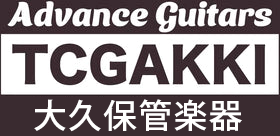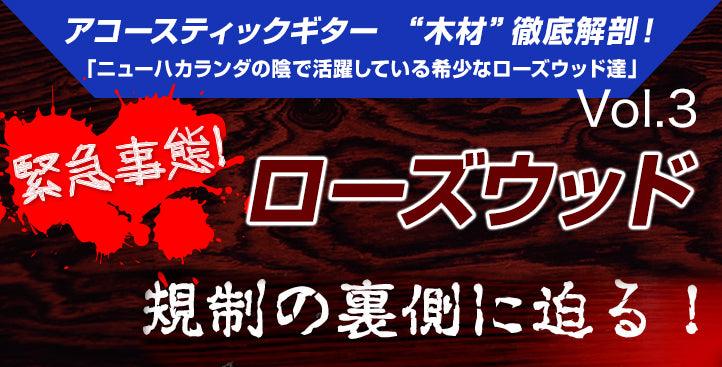The "New Hakaranda" (see Vol. 2) is now a rare material.
In such a situation, "Post-Hakaranda" woods have appeared.
Many of them have already become rare as well,
Various rare rosewood species are used by various makers.
Many of them have good acoustic properties,
Some of them are traded on par with Hakaranda...!
Here we introduce some of them!

Although the name "rosewood" is not included in the species name, it is a genuine rosewood that belongs to the same genus, Dalbergia, as Hakaranda and other rosewood species.
It is one of the "Latin American rosewoods" and is widely used by major makers such as Martin and Taylor, as well as high-end private workshops.
It has a reddish color compared to other rosewoods, and its exotic grain is as beautiful as that of Hakaranda,
It is harder than Hakaranda, and its glossy and juicy sound with high oil content and low center of gravity has a very fine feel and sound compared to other rosewood species.
It is endangered and is already sold at a high price as a rare wood.
Martin D-45
Martin's top-of-the-line D-45.
In recent years, various reissues, custom models, and limited models have been released.
In recent years, models using cocobolo as well as Madagascar Rose have been made for the high-end ranks.
This is a 2012 D-45 CTM-D Style42 Cocobolo.
This D-42 style model has a top made of high-grade Italian alpine spruce.
The straight and clear grain is beautiful, and the bright reddish part and the darker black part are clearly shaded.
The sound is solid and hard, with plenty of power.
This is a custom model that is not produced regularly due to the rarity of the wood.

Taylor
Along with Martin and Gibson, Taylor is one of the most popular acoustic guitars made overseas.
The guitars feature modern elements such as models with preamps, cutaways, bolt-on joints, etc., rather than traditional styles, so that they can adapt to modern music.
While innovations such as the introduction of computer-controlled construction methods are also being made, the company is also known for its attention to wood, and a variety of models are being developed and gaining popularity.

This is a 2002 714ce LTD.
The small body and cutaway GA shape are the most popular in Japan.
Taylor regularly releases limited models in limited production, and the rare Cocobolo wood is often used in their high-end models.
It matches very well with the easy-to-play and responsive feel of Taylor's high precision workmanship, and while it has a bright and good response, it also has a moist and wet texture that can be felt in its fine quality.

Camatillo is also known as "Mexican Kingwood. It is generally considered to be the Mexican version of the famous Brazilian Kingwood, a wood for which little information is available. Like Cocobolo, Camatillo is a genuine rosewood species (genus Dalbergia), and is characterized by its bright purple grain.
It is characterized by exotic grain patterns similar to cocobolo, and is very beautiful compared to other species.
It has a high specific gravity and a hard, dry texture. It is characterized by its hard and dry texture, and has a rangy and bouncy sound.

Yokoyama Guitars
Tadashi Yokoyama, a former Morris craftsman who is also known for developing the Morris S series, has his own workshop in Nagano.
Each guitar made with his high level of woodworking technique has its own character and warmth,
Each guitar made with their high level of woodworking skills is unique and has a sense of warmth. Each guitar is unique and has a sense of warmth.

This is the SJF-WC from the SJF series, one of Yokoyama Guitars' popular models.
The combination of a small jumbo with a florentine cutaway and the luxurious use of Camatillo wood make this a beautiful guitar.
Three-piece back with exotic grain flowing in all directions.
The sap is also cool.
This guitar has a unique sound that cannot be achieved by any other acoustic guitar maker.

This is the back of the AR-GC, the most popular model in the AR series, also from Yokoyama Guitars.
The back is a very rare wood grain, made of "almost" sap rather than 2-piece back. The fiery grain and the pure white sapphire look are very unique.
Yokoyama's workshop regularly stops production and orders of Camatillo models due to the scarcity of the wood, and produces them on a limited basis when he can secure the wood. In recent years, there have been many three- to five-piece backs, indicating the difficulty in obtaining the material.

The standard Japanese name for rosewood is "cittern.
Its scientific name, Dalbergia cochinchinensis, is also found in Thailand and Vietnam.
It is also known as "Thai rosewood," "Vietnamese rosewood," "Siamese rosewood," "pion," and so on, depending on the country of origin. Here we describe Cambodian rosewood, which is native to Cambodia.

Water Road Guitars
Water Road Guitars is a well-known high-end guitar brand produced by builder Akio Masuda.
Water Road" means "water road" in literal translation, and is derived from Mr. Masuda's main business as a plumber.
In addition to original designs and inlays, Masuda also produces guitars with a variety of other details, such as carbon reinforcement to make the thin necks more practical.

This is Water Road Guitars' small jumbo type Libero Arte.
The guitars are made of Cambodian rosewood, which is very rare and precious.
Few makers use Cambodian rosewood in their acoustic guitars, and the sound of this wood is rare,
This is a rare one that allows you to experience the sound of this wood.
The grain of the wood is similar to Indian rosewood, but has a unique reddish color and undulation, and sap can also be seen in the book match section.
The woody, wide range, and bottomless density of the sound is achieved by handcrafted workmanship, and the sound is clear and loud.
The potential of Cambodian rosewood can be glimpsed.
Postscript
This time, I would like to introduce Madagascar Rose and Hong Rose.
and Hong Rose, which are rare rosewood species that have been active in the shadow of New Hakaranda!
The New Hakaranda is no longer a
not a substitute wood, but each has its own value and is highly valued!
Even though they are very suitable for instruments,
Although it is very suitable for instruments, there are only a small number of pieces available, and only a few makers use it,
It is very difficult to gather information on them.
And the post-Hakaranda attack continues...

